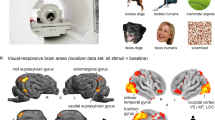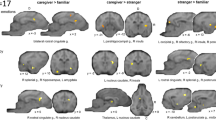Abstract
This study investigated the behavioral and neural indices of detecting facial familiarity and facial emotions in human faces by dogs. Awake canine fMRI was used to evaluate dogs’ neural response to pictures and videos of familiar and unfamiliar human faces, which contained positive, neutral, and negative emotional expressions. The dog–human relationship was behaviorally characterized out-of-scanner using an unsolvable task. The caudate, hippocampus, and amygdala, mainly implicated in reward, familiarity and emotion processing, respectively, were activated in dogs when viewing familiar and emotionally salient human faces. Further, the magnitude of activation in these regions correlated with the duration for which dogs showed human-oriented behavior towards a familiar (as opposed to unfamiliar) person in the unsolvable task. These findings provide a bio-behavioral basis for the underlying markers and functions of human–dog interaction as they relate to familiarity and emotion in human faces.









Similar content being viewed by others
References
Adachi I, Kuwahata H, Fujita K (2007) Dogs recall their owner’s face upon hearing the owner’s voice. AnimCogn 10(1):17–21
Bach J-P, Lüpke M, Dziallas P, Wefstaedt P, Uppenkamp S, Seifert H, Nolte I (2013) Functional magnetic resonance imaging of the ascending stages of the auditory system in dogs. BMC Veterinary Res 9:210
Berns GS, Brooks AM, Spivak M (2015) Scent of the familiar: an fMRI study of canine brain responses to familiar and unfamiliar human and dog odors. Behav Proc 110:37–46
Bzdok D, Laird AR, Zilles K, Fox PT, Eickhoff SB (2013) An investigation of the structural, connectional, and functional subspecialization in the human amygdala. Hum Brain Map 34(12):3247–3266
Bunford N, Hernández-Pérez R, Farkas EB, Cuaya LV, Szabó D, Szabó ÁG et al (2020) Comparative brain imaging reveals analogous and divergent patterns of species and face sensitivity in humans and dogs. J Neurosci 40(43):8396–8408
Choi EY, Yeo BT, Buckner RL (2012) The organization of the human striatum estimated by intrinsic functional connectivity. J Neurophysiol 108(8):2242–2263
Cook PF, Spivak M, Berns GS (2014) One pair of hands is not like another: caudate BOLD response in dogs depends on signal source and canine temperament. PeerJ 2:e596
Coulon M, Deputte BL, Heyman Y, Baudoin C (2009) Individual recognition in domestic cattle (Bos taurus): evidence from 2D-images of heads from different breeds. PLoS ONE 4(2):e4441
Cuaya LV, Hernández-Pérez R, Concha L (2016) Our faces in the dog’s brain: functional imaging reveals temporal cortex activation during perception of human faces. PLoS ONE 11(3):e4441
Dilks DD, Cook P, Weiller SK, Berns HP, Spivak M, Berns GS (2015) Awake fMRI reveals a specialized region in dog temporal cortex for face processing. PeerJ 3:e0149431
Dyer AG, Neumeyer C, Chittka L (2005) Honeybee (Apismellifera) vision can discriminate between and recognise images of human faces. J ExpBiol 208(24):4709–4714
Hadj-Bouziane F, Liu N, Bell AH, Gothard KM, Luh WM, Tootell RB et al (2012) Amygdala lesions disrupt modulation of functional MRI activity evoked by facial expression in the monkey inferior temporal cortex. Proc Natl AcadSci 109(52):3640–3648
Haxby JV, Hoffman EA, Gobbini MI (2000) The distributed human neural system for face perception. Trends Cognit Sci 4(6):223–233
Hori Y, Kishi H, Inoue-Murayama M, Fujita K (2011) Individual variability in response to human facial expression among dogs. J Veterinary BehavClinAppl Res 6(1):70
Horn L, Virányi Z, Miklósi Á, Huber L, Range F (2012) Domestic dogs (Canis familiaris) flexibly adjust their human-directed behavior to the actions of their human partners in a problem situation. AnimCogn 15(1):57–71
Huang H, Nguyen PT, Schwab NA, Tanner JJ, Price CC, Ding M (2017) Mapping dorsal and ventral caudate in older adults: method and validation. Front Aging Neurosci 9:91
Iidaka T, Terashima S, Yamashita K, Okada T, Sadato N, Yonekura Y (2003) Dissociable neural responses in the hippocampus to the retrieval of facial identity and emotion: an event-related fMRI study. Hippocampus 13(4):429–436
Jia H, Pustovyy OM, Waggoner P, Beyers RJ, Schumacher J, Wildey C et al (2014) Functional MRI of the olfactory system in conscious dogs. PLoS One 9(1).
Jia H, Pustovyy OM, Wang Y, Waggoner P, Beyers RJ, Schumacher J et al (2016) Enhancement of odor-induced activity in the canine brain by zinc nanoparticles: a functional MRI study in fully unrestrained conscious dogs. Chem Senses 41(1):53–67
Knolle F, Goncalves RP, Morton AJ (2017) Sheep recognize familiar and unfamiliar human faces from two-dimensional images. R Soc Open Sci 4(11):171228
Kyathanahally SP, Jia H, Pustovyy OM, Waggoner P, Beyers R, Schumacher J et al (2015) Anterior–posterior dissociation of the default mode network in dogs. Brain StructFunct 220(2):1063–1076
Lazarowski L, Thompkins A, Krichbaum S, Waggoner LP, Deshpande G, Katz JS (2020) Comparing pet and detection dogs (Canis familiaris) on two aspects of social cognition. Learn Behav 48(4):432–443. https://doi.org/10.3758/s13420-020-00431-8
Mars RB, Sallet J, Neubert FX, Rushworth MFS (2013) Connectivity profiles reveal the relationship between brain areas for social cognition in human and monkey temporoparietal cortex. Proc Natl AcadSci 110:10806–10811
Mars RB, Verhagen L, Gladwin TE, Neubert FX, Sallet J, Rushworth MFS (2016) Comparing brains by matching connectivity fingerprints. NeurosciBiobehav Rev 60:90–97
Marshall-Pescini S, Passalacqua C, Barnard S, Valsecchi P, Prato-Previde E (2009) Agility and search and rescue training differently affects pet dogs’ behaviour in socio-cognitive tasks. Behav Proc 81(3):416–422
Martín-Vaquero P, da Costa RC, Echandi RL, Tosti CL, Knopp MV, Sammet S (2010) Magnetic resonance imaging of the canine brain At 3 and 7T. Veterinary Radiol Ultrasound
Miklósi Á, Kubinyi E, Topál J, Gácsi M, Virányi Z, Csányi V (2003) A simple reason for a big difference: wolves do not look back at humans, but dogs do. CurrBiol 13(9):763–766
Miller PE, Murphy CJ (1995) Vision in dogs. J Am Veterinary Med Assoc 207:1623–1634
Müller CA, Schmitt K, Barber AL, Huber L (2015) Dogs can discriminate emotional expressions of human faces. CurrBiol 25(5):601–605
Newport C, Wallis G, Reshitnyk Y, Siebeck UE (2016) Discrimination of human faces by archerfish (Toxoteschatareus). Sci Rep 6:27523
Paller KA, Ranganath C, Gonsalves B, LaBar KS, Parrish TB, Gitelman DR et al (2003) Neural correlates of person recognition. Learn Memory 10(4):253–260
Parr LA, de Waal FB (1999) Visual kin recognition in chimpanzees. Nature 399(6737):647
Passalacqua C, Marshall-Pescini S, Merola I, Palestrini C, Previde EP (2013) Different problem-solving strategies in dogs diagnosed with anxiety-related disorders and control dogs in an unsolvable task paradigm. ApplAnimBehavSci 147(1–2):139–148
Phelps EA, LeDoux JE (2005) Contributions of the amygdala to emotion processing: from animal models to human behavior. Neuron 48(2):175–187
Quaranta A, Siniscalchi M, Vallortigara G (2007) Asymmetric tail-wagging responses by dogs to different emotive stimuli. CurrBiol 17(6):R199–R201
Ramaihgari B, Pustovyy OM, Waggoner P, Beyers RJ, Wildey C, Morrison E et al (2018) Zinc nanoparticles enhance brain connectivity in the canine olfactory network: evidence from an fMRI study in unrestrained awake dogs. Front Veterinary Sci 5:127
Robinson JL, Barron DS, Kirby LA, Bottenhorn KL, Hill AC, Murphy JE et al (2015) Neurofunctional topography of the human hippocampus. Hum Brain Mapp 36(12):5018–5037
Robinson JL, Baxi M, Katz JS, Waggoner P, Beyers R, Morrison E et al (2016) Characterization of structural connectivity of the default mode network in dogs using diffusion tensor imaging. Sci Rep 6:36851
Rooney NJ, Bradshaw JW, Almey H (2004) Attributes of specialist search dogs—a questionnaire survey of UK dog handlers and trainers. J Forensic Sci 49(2):1–7
Siegel JS, Power JD, Dubis JW, Vogel AC, Church JA, Schlaggar BL, Petersen SE (2014) Statistical improvements in functional magnetic resonance imaging analyses produced by censoring high-motion data points. Hum Brain Mapp 35(5):1981–1996
Sliwa J, Planté A, Duhamel JR, Wirth S (2014) Independent neuronal representation of facial and vocal identity in the monkey hippocampus and inferotemporal cortex. Cereb Cortex 26(3):950–966
Smith AV, Proops L, Grounds K, Wathan J, McComb K (2016) Functionally relevant responses to human facial expressions of emotion in the domestic horse (Equuscaballus). Biol Let 12(2):20150907
Stoeckel LE, Palley LS, Gollub RL, Niemi SM, Evins AE (2014) Patterns of brain activation when mothers view their own child and dog: an fMRI study. PLoS ONE 9(10):e107205
Strassberg LR, Waggoner LP, Deshpande G, Katz JS (2019) Training dogs for awake, unrestrained functional magnetic resonance imaging. JoVE (J Vis Exp) 152:e60192
Su M-Y, Tapp PD, Vu L, Chen Y-F, Chu Y, Muggenburg B et al (2005) A longitudinal study of brain morphometrics using serial magnetic resonance imaging analysis in a canine model of aging. ProgNeuropsychopharmacolBiol Psychiatry 29(3):389–397
Szabó D, Gábor A, Gácsi M, Faragó T, Kubinyi E, Miklósi Á, Andics A (2020) On the face of it: no differential sensitivity to internal facial features in the dog brain. Front BehavNeurosci 14:389–397
Thompkins AM, Deshpande G, Waggoner P, Katz JS (2016) Functional magnetic resonance imaging of the domestic dog: research, methodology, and conceptual issues. Comp CognitBehav Rev 11:63
Thompkins AM, Ramaiahgari B, Zhao S, Gotoor SSR, Waggoner P, Denney TS et al (2018) Separate brain areas for processing human and dog faces as revealed by awake fMRI in dogs (Canis familiaris). Learn Behav 46(4):561–573
Venn RE, McBrearty AR, McKeegan D, Penderis J (2014) The effect of magnetic resonance imaging noise on cochlear function in dogs. Veterinary J 202(1):141–145
Watanabe S, Ito Y (1990) Discrimination of individuals in pigeons. Bird Behav 9(1–2):20–29
Acknowledgements
We are grateful to the trainers of ik9, LLC and Auburn University’s Canine Performance Sciences for participating in this study. We also thank members of the Comparative Cognition Lab for assistance with data collection and scoring. We are especially grateful to the Auburn University MRI Research center for accommodating behavioral testing. This study was supported in part by the Defense Advanced Research Projects Agency (government contract/grant number W911QX-13-C-0123). The views, opinions, and/or findings contained in this article are those of the authors and should not be interpreted as representing the official views or policies, either expressed or implied, of the Defense Advanced Research Projects Agency, US Department of Defense or the Federal Government of the United States.
Author information
Authors and Affiliations
Contributions
AT, JK, and GD designed the study. BR, SG, and GD conducted neuroimaging and analysis. PW designed and supervised dog training. TD supervised neuroimaging. AT designed, conducted and analyzed data for the behavioral measure. LL conducted the behavioral measure. JK supervised behavioral data analysis. AT, JK, LL, and GD prepared the manuscript.
Corresponding author
Additional information
Publisher's Note
Springer Nature remains neutral with regard to jurisdictional claims in published maps and institutional affiliations.
Rights and permissions
About this article
Cite this article
Thompkins, A.M., Lazarowski, L., Ramaiahgari, B. et al. Dog–human social relationship: representation of human face familiarity and emotions in the dog brain. Anim Cogn 24, 251–266 (2021). https://doi.org/10.1007/s10071-021-01475-7
Received:
Revised:
Accepted:
Published:
Issue Date:
DOI: https://doi.org/10.1007/s10071-021-01475-7




